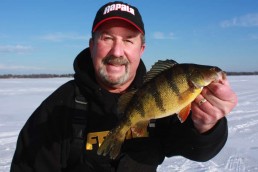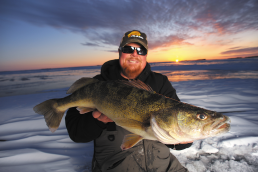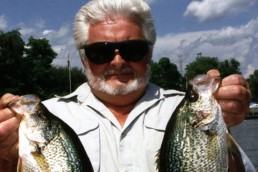Check the Ice and Cash in on Late Winter Panfish
SHARE THIS POST
As we get into the last weeks and days of ice fishing there is a phenomenon that occurs with panfish—we’re talking bull bluegills, mumbo jumbo perch and big crappies. As the sun begins to melt away the ice with a renewed intensity, panfish sense the changes and will adapt to the microorganisms that appear just before break-up.
Safety is always a must, and at late ice it’s even more important. Always walk and use a chisel ahead to make sure the honeycombed March ice is strong enough to support your weight. Always tell someone where you are going and wear a life jacket when venturing out.
There are all kinds of critters, from bloodworms to stages of larvae, which abound beneath the late stages of ice. And the different species of panfish are right on target to devour everything in their path.
Often, I’ve taken numbers of bluegills directly under the ice in 12 to 16 feet of water. With the oxygen-filled, honeycombed ice, and the driving force to nourish their systems before spawn, this is a ritual that repeats itself season after season. Small jigs and spoons offer the size and shape of just what the doctor ordered. Attach two or three wiggly euro larvae and you are definitely serving up lunch.
Are you enjoying this post?
You can be among the first to get the latest info on where to go, what to use and how to use it!
Jumbo perch most often are shallow at last ice, and can be found with regularity in depths of 6-10 feet. Gravel, shallow rocks, and scattered weed growth will hold numbers of big perch at last ice. For this application, I prefer my Ice-55 with the wide-angle 19-degree transducer cone setting to give me a better look at what’s available. Small spoons baited with a minnow head or small VMC Pug Bug jig with 3 to 4 euro larvae are deadly for late-ice perch. Keep drilling and moving until you find the hot hole.
Late-ice crappies are quite nomadic and can be found in several depth ranges. I will check depths of 20 to 24 feet near a shallow ledge that has a soft mud bottom. Crappies are dialed into massive bloodworm locations and will migrate to the shallows at dusk or dark. Several different baits do a good job, but I like a small 1/32- or 1/64-ounce tungsten Tubby Jig with several grubs attached or a minnow tail or head for scent. Remember to keep hole-hopping and pay attention to your electronics until you locate the fish.
Late ice can be fulfilling, but caution and safety are a must. The intense rays of the sun bring about nature’s change and a few nice fish, and the warmth of spring make late ice worth trying.
MWO
SHARE THIS POST
Did you enjoy this post?
You can be among the first to get the latest info on where to go, what to use and how to use it!



